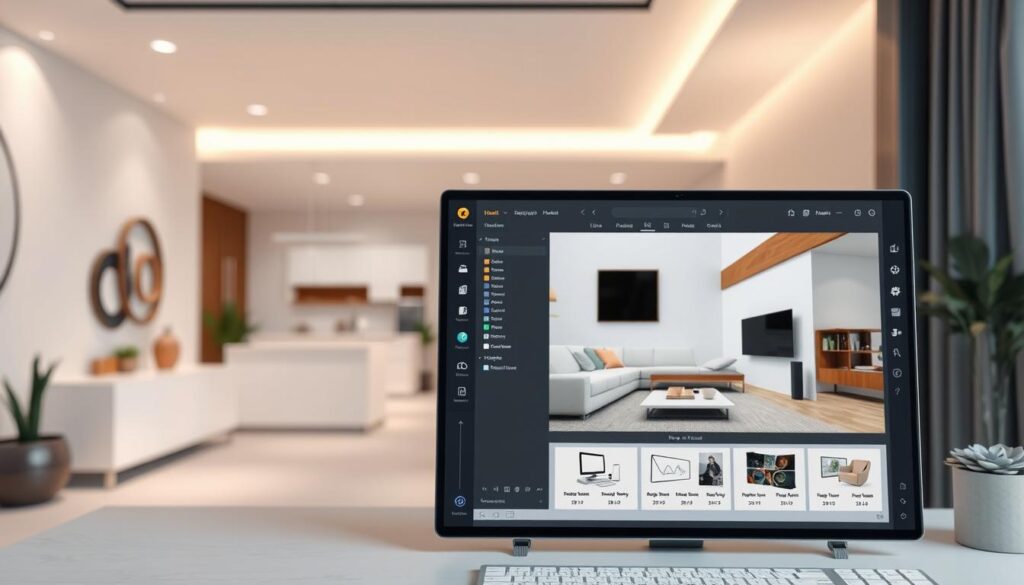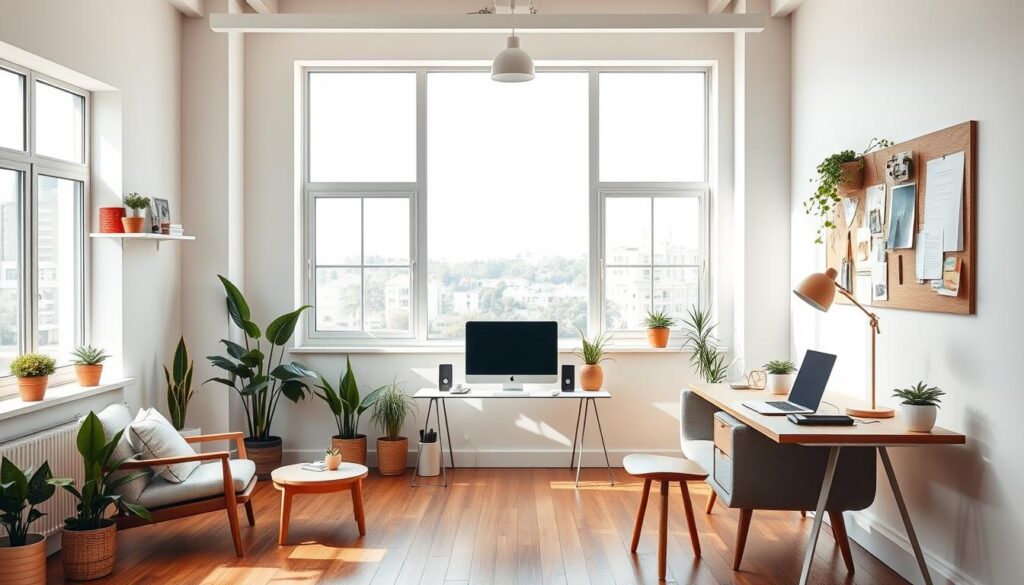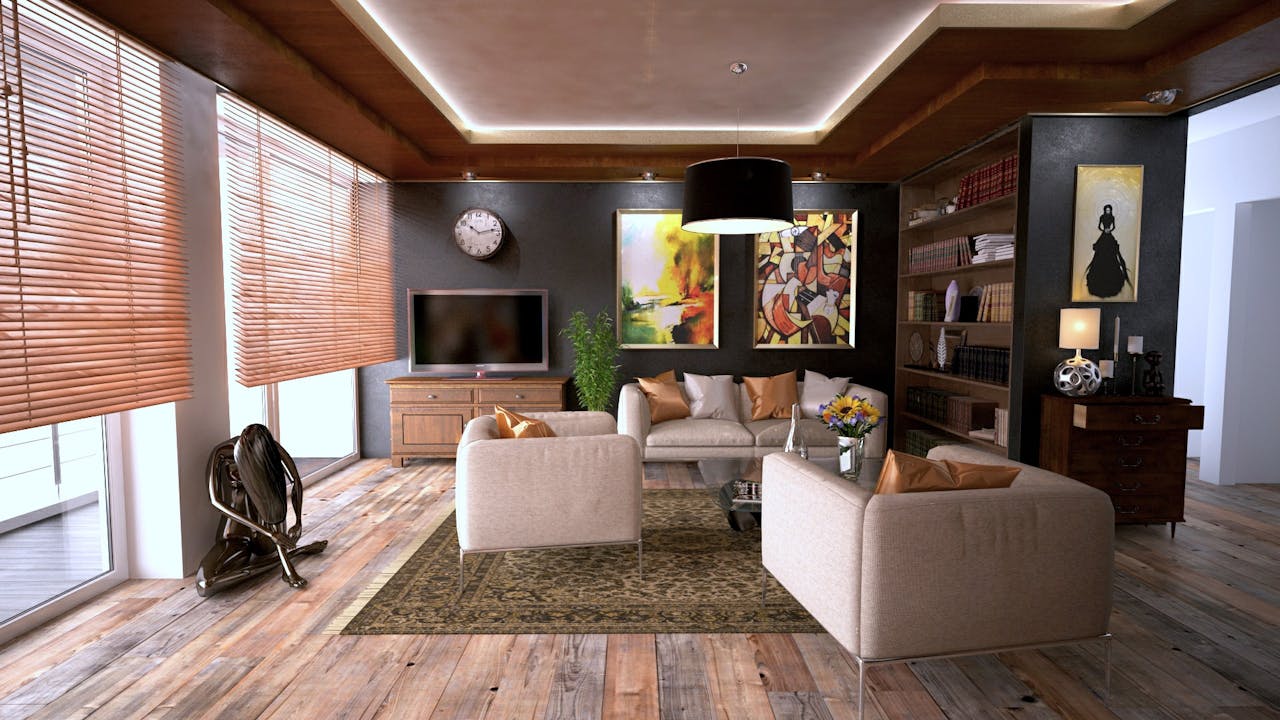The interior design industry is booming. The Bureau of Labor Statistics predicts a 5% growth in jobs for interior designers from 2020 to 2030.
Exploring a career in interior design is exciting. Interior designers create spaces that are both beautiful and functional. They meet their clients’ needs, needing to know design principles and technical skills like CAD software.
As the demand for skilled designers grows, we’ll look at education, skills, and job chances. These can help you thrive in this dynamic field.
Key Takeaways
- Understanding the role and responsibilities of an interior designer is crucial.
- A strong foundation in design principles and technical skills is necessary.
- The interior design industry is booming, with growing demand for professionals.
- Education and skills are key to succeeding in this field.
- Job opportunities in interior design are diverse and expanding.
Understanding the Role of an Interior Designer
To be a great interior designer, you need to understand the job’s many sides. It’s about both technical skills and creative ideas. Designers make spaces that look good, work well, and are safe.
What Does an Interior Designer Do?
Interior designers make spaces better for people. They do this by knowing what clients want and making it happen. They pick colors, furniture, and plan room layouts.
We talk to clients to get what they need. Our jobs include:
- Looking at the space and figuring out what’s needed
- Picking materials, finishes, and furniture
- Making sure designs follow laws and rules
- Watching the design go in
Skills Needed for Interior Design
To be good at interior design, you need creativity, technical skills, and people skills. Creativity helps make new designs that clients love. Technical skills, like using CAD software, are key for making detailed plans and working with contractors.
Important skills include:
- Creativity and paying attention to details
- Being good at talking and working with people
- Knowing design software well
- Understanding building codes, safety rules, and green practices
Different Types of Interior Design
Interior design covers many areas, like homes, offices, and hotels. Each area needs its own special approach and knowledge.
Residential design makes homes cozy and useful for families. Commercial design focuses on improving work and shopping spaces. It aims to boost productivity and customer happiness.
Educational Pathways for Aspiring Designers
Starting a career in interior design requires choosing the right path. You have many options based on your goals, budget, and how you learn best. Each choice can shape your future in design.
Formal Education Options
Getting a degree is key for aspiring designers. Degree programs in interior design or related fields teach the basics of design. You’ll learn about space planning and color theory.
An associate’s degree takes two years and covers the essentials. A bachelor’s degree, which takes four years, dives deeper into design and business skills.
Online Learning Opportunities
Online interior design courses offer flexibility. They range from certificates to training in design software. You can study anytime, anywhere, fitting it into your schedule.
MOOCs and interior design certification programs are popular online. They’re great for learning specific skills, like sustainable design.
Certifications in Interior Design
A professional certification in interior design, like NCIDQ, boosts your career. It shows you’re dedicated and skilled. This can help you stand out in the job market.
The NCIDQ certification is highly respected. It’s often needed for top jobs or starting your own firm. To prepare, you need education and work experience, plus exam prep courses.
Gaining Experience in the Field
Practical experience is key for a successful interior design career. It builds the skills and confidence needed. For aspiring designers, getting hands-on experience is vital for improving interior design skills and boosting interior design job prospects.
Internships and Apprenticeships
Internships and apprenticeships are great ways to get experience. They let you work with experienced designers, learning the job’s details. This real-world experience is invaluable.
Industry experts say internships make a candidate’s resume stand out. This makes them more appealing to employers.
“Internships provide a unique opportunity for students and newcomers to gain practical experience and make industry connections that can be invaluable in their future careers.”
To find internships or apprenticeships, aspiring designers can:
- Check with professional organizations like the American Society of Interior Designers (ASID) for listings.
- Network with professionals in the field through events and online platforms.
- Reach out to design firms directly to inquire about potential opportunities.
Freelancing as a Beginner
Freelancing is a good option for beginners. It lets you work on small projects, build your portfolio, and get clients. Freelancing also offers the chance to work on different projects, broadening your experience and skills.
To succeed as a freelancer, it’s essential to:
- Set clear boundaries and expectations with clients.
- Continuously update and refine your interior design portfolio to showcase your best work.
- Stay organized and manage your time effectively to meet deadlines.
| Experience Type | Benefits | Skills Developed |
|---|---|---|
| Internships | Hands-on experience, industry connections | Design software proficiency, project management |
| Freelancing | Portfolio building, client management | Time management, communication skills |
| Apprenticeships | Mentorship, practical skills | Space planning, material selection |
Building a Portfolio
A strong interior design portfolio is key for showing off your skills and experience. It should include a variety of projects to show your versatility and creativity.
When building a portfolio, consider the following:
- Include a mix of academic and professional projects.
- Highlight your role in each project and the skills you applied.
- Use high-quality images and clear descriptions.
By focusing on gaining practical experience through internships, freelancing, and building a comprehensive portfolio, aspiring interior designers can significantly enhance their interior design job prospects. This sets them up for success in the competitive world of interior design.
Networking and Professional Development
As we move forward in our interior design career, networking and professional growth are key. Building a strong network and keeping up with interior design industry trends can boost our career.
Joining professional groups is a smart move to grow our network. Groups like the American Society of Interior Designers (ASID) offer many benefits. These include access to special events, educational materials, and chances to meet other designers. The “The State of the Interior Design Industry” report shows that being part of these groups can make us happier at work and help us advance in our careers.
Joining Professional Organizations
Being a member of professional groups keeps us in the loop about industry news. For example, ASID gives its members access to learning programs, networking events, and advocacy efforts. These help us keep up with industry standards and best practices.
As
“Networking is not about just connecting people. It’s about connecting people with people, people with opportunities, and people with ideas.”
This quote shows how important networking is for our growth.
Attending Industry Events
Going to industry events, conferences, and trade shows is crucial for networking. These events let us meet potential clients, learn about new design tools, and keep up with interior design industry trends. We can also show off our interior design portfolio to employers or clients, making us more visible in the field.
Finding a Mentor
Finding a mentor who knows the field well can be very helpful. A mentor can share industry insights, help us through tough times, and give feedback on our work, including our interior design portfolio. This mentorship can be key in shaping our interior design career and helping us reach our goals.
In conclusion, networking and professional growth are vital for a successful interior design career. By joining groups, attending events, and finding a mentor, we can lay a strong foundation for our career and stay current with industry trends.
Understanding Industry Standards and Regulations
To excel as interior designers, we must know the standards and regulations of our field. These guidelines are not just about following rules. They ensure the safety, accessibility, and sustainability of the spaces we create.
Code of Ethics in Interior Design
A code of ethics is the foundation of our profession. It outlines the principles and standards that guide our decisions. The American Society of Interior Designers (ASID) and the International Interior Design Association (IIDA) have set these codes. They stress the importance of protecting clients’ health, safety, and welfare.
Key elements of a code of ethics include:
- Maintaining confidentiality and handling conflicts of interest
- Complying with laws and regulations
- Continuing education and professional development
- Respecting the environment and promoting sustainability
Licensing Requirements in the U.S.
Licensing for interior designers varies by state. This reflects the diverse needs and regulations across the country. Several states require licensure or registration. The National Council for Interior Design Qualification (NCIDQ) exam is widely recognized as a standard for professional competence.
| State | Licensing Requirement | Certification Recognized |
|---|---|---|
| California | Licensure required | NCIDQ |
| New York | Registration required | NCIDQ |
| Florida | Licensure required | NCIDQ |
The Importance of Continuing Education
The interior design industry is always changing. New technologies, materials, and best practices emerge regularly. Continuing education is key to staying current and providing top service to clients.
Continuing education benefits include:
- Enhancing technical skills and knowledge
- Staying abreast of industry trends and innovations
- Networking opportunities with peers and industry leaders
As we navigate our careers, embracing lifelong learning is crucial. It’s not just about meeting regulatory requirements. It’s about delivering exceptional design solutions that meet our clients’ changing needs.
Mastering Design Software and Tools
In today’s world, interior designers need to know how to use design software well. The field has changed a lot with technology. Knowing how to use software is key to doing well.
Popular Interior Design Software
Many software programs are used in interior design. These include:
- CAD (Computer-Aided Design) software for precise drafting and documentation.
- SketchUp for creating 3D models and visualizations.
- Revit for building information modeling (BIM).
These tools help designers make detailed designs, see spaces in 3D, and work better with clients and contractors.

Building Your Technical Skills
Getting good at design software takes time and effort. Here’s how to improve:
- Start with the basics and then learn more advanced things.
- Practice often to get better.
- Take part in online tutorials and workshops to learn about new software features.
As we keep working on our skills, we can get better at interior design and stay ahead in the field.
Resources for Software Training
There are lots of places to learn about software, including:
| Resource | Description |
|---|---|
| Online Tutorials | Websites like YouTube and Udemy have lots of tutorials for different design software. |
| Workshops and Conferences | Industry events are great for learning from experts and meeting others in the field. |
| Software Manufacturer Sites | Companies like Autodesk offer training and certification programs. |
“The right tools can make all the difference in delivering high-quality designs and meeting client expectations.” – Industry Expert
By using these resources, we can get better at design software. This can help us improve our interior design career. We might even get interior design certification to show off our skills.
Finding Your Design Style
Discovering your interior design style is a journey of exploration and creativity. It’s about understanding what you like and what makes your work stand out.
Exploring Different Design Aesthetics
Start by exploring various design styles. Learn about modern, minimalist, industrial, and bohemian aesthetics. Each style has its own rules and looks.
Modern design is all about simplicity and function. Bohemian style, on the other hand, is about mixing vintage and global elements. It’s all about rich textures and a laid-back vibe.
Mixing and Matching Styles
After exploring, mix and match styles to find what’s uniquely yours. You might blend modern’s simplicity with traditional’s warmth.
Here are some tips for a cohesive look:
- Find common elements you like from different styles.
- Play with textures and materials to add depth.
- Balance contrasting elements for visual harmony.
The Importance of Personal Branding
Your design style is key to your personal brand. It shows your values, taste, and identity to clients and partners.
A strong brand sets you apart and makes your work memorable. To build your brand, focus on:
| Aspect | Description | Example |
|---|---|---|
| Visual Identity | Logo, color palette, typography | A logo that reflects your style |
| Portfolio | A showcase of your best work | Projects that show your aesthetic |
| Online Presence | Website, social media profiles | A website that tells your brand story |
By focusing on your style and branding, you’ll build a strong identity. This will attract your target audience.
Marketing Yourself as an Interior Designer
As interior designers, we know that a great design style is just the start. We must also market ourselves well to attract clients and grow our business. In today’s competitive world, a solid marketing plan is key to interior design job prospects and career growth.
Creating an Online Presence
First, we need a professional online presence. This means having a website that showcases our interior design portfolio. Our site should be easy to use, work well on mobile devices, and have a clear call-to-action to encourage contact from potential clients.
For more tips on online presence, check out Foyr. They offer great advice on marketing for interior designers.
Networking on Social Media
Networking on social media is also vital. Sites like Instagram, Pinterest, and Houzz let us share our work, connect with clients, and keep up with interior design industry trends. By posting quality content and talking to our followers, we can grow a strong online community around our brand.

Utilizing Traditional Marketing Methods
Even though digital marketing is important, traditional methods still play a role. This includes print ads in design magazines, attending events, and entering design contests. Mixing online and offline marketing helps us reach more people and boosts our success chances.
Effective marketing for interior designers means using both digital and traditional methods. By focusing on a strong online presence, social media networking, and traditional marketing, we can promote our services and draw in new clients in a competitive market.
Tips for Launching Your Interior Design Career
Now that we’ve covered how to become an interior designer, it’s time to start your career. Launching a successful career in interior design needs careful planning and staying current with trends.
Establishing a Strong Foundation
Starting your business means registering it, getting the right licenses, and making a detailed business plan. This step is key to your success. It should be based on your knowledge of interior design courses and standards.
Pricing and Client Relationships
Figuring out your pricing is important. You need to understand the market well. Building strong client relationships is also crucial. This comes from great customer service and clear communication.
By following these tips and keeping up with your professional growth, you can overcome the interior design industry’s challenges. You’ll be on your way to a successful career.



